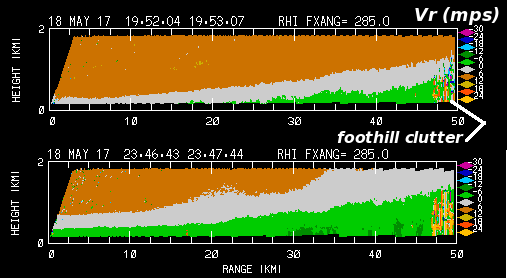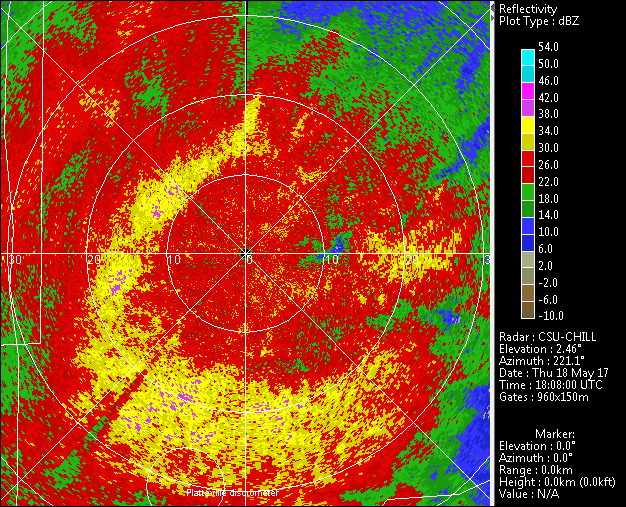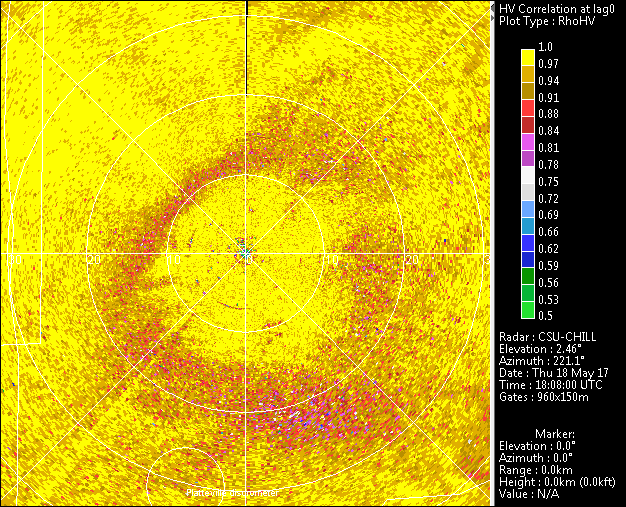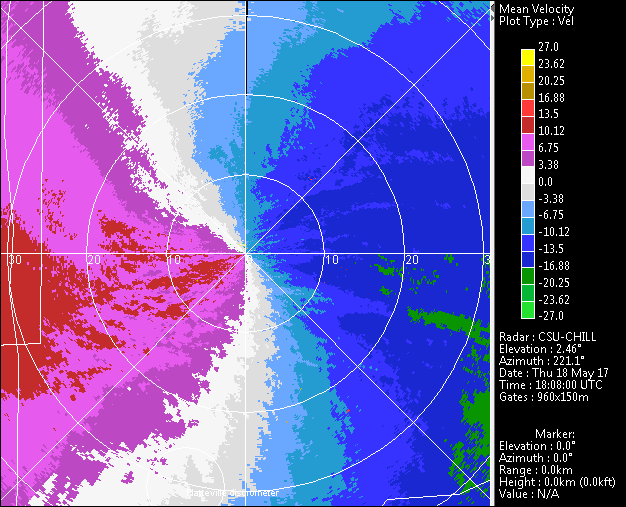DPWX/Descending melting level: 18 May 2017: Difference between revisions
Pat kennedy (talk | contribs) No edit summary |
Pat kennedy (talk | contribs) No edit summary |
||
| Line 1: | Line 1: | ||
==Overview== | ==Overview== | ||
A significant late spring storm started affecting much of the CSU-CHILL radar coverage area during the morning hours 18 May 2017. Wet snow accumulated at the higher terrain elevations around Fort Collins (~ | A significant late spring storm started affecting much of the CSU-CHILL radar coverage area during the morning hours 18 May 2017. Wet snow accumulated at the higher terrain elevations around Fort Collins (~1530 m MSL). At the slightly lower (1432 m MSL) CHILL radar site the precipitation was mostly rain until the mid to late afternoon hours (all of the above-mentioned times are local). The CSU-CHILL conducted 360 PPI scans during much of this event. The descent of the melting level towards the surface in the CHILL / Greeley area was observed in the co-polar correlation coefficient (RHoHV) dual polarization data field. | ||
==Reflectivity loop== | ==Reflectivity loop== | ||
The following loop shows the reflectivity data observed in the 1.7 degree elevation PPI scans. The time interval between the scans is slightly over 6 minutes. The organization of the high reflectivity features undergoes significant, rapid fluctuations. The presence of melting snow particles probably contributes to these localized reflectivity maxima | The following loop shows the reflectivity data observed in the 1.7 degree elevation PPI scans. The time interval between the scans is slightly over 6 minutes. The organization of the high reflectivity features undergoes significant, rapid fluctuations. The presence of melting snow particles probably contributes to these localized reflectivity maxima. | ||
<center> | <center> | ||
| Line 54: | Line 54: | ||
==RhoHV loop== | ==RhoHV loop== | ||
The co-polar correlation coefficient (RhoHV) field from the same series of sweeps is shown in the following loop. This correlation value is reduced when the radar pulse volume contains a wide variety of hydrometeor types, shapes, and orientation angles. This diverse particle population often exists in precipitation areas just below the 0C environmental temperature level. In this area, smaller hydrometeors rapidly melt into quasi-spherical liquid drops while the larger, more irregularly shaped aggregated snow particles are still melting. More uniform hydrometeor populations exist above the melting layer, where the particles are generally all composed of ice. Similarly, well below the melting level, all of the hydrometeors have melted into liquid drops. The net result is that the melting zone is associated with a layer of locally reduced RhoHV. In a PPI scan, this RhoHV minimum occurs at the range where the radar beam passes through the melting zone. In the case of a descending melting level, the radar range to the reduced RhoHV region will decrease with time. Such a "shrinking" RhoHV ring can be seen in the following image loop as the overall rain to snow transition occurred at Greeley. The prevailing visibility and precipitation types reported in the Greeley Airport (KXGY) AWOS A03 METAR observations have been inserted in the lower portion of the image frames. Reports of unknown precipitation (UP) generally occurred when reduced RhoHV was near the AWOS site (azimuth 160 degrees range 1.2 km from CSU-CHILL). | |||
<center> | <center> | ||
<imgloop delay=200 imgprefix="http://www.chill.colostate.edu/anim/jun_2017_18may2017_GXY_UP/" width=626 height=507> | <imgloop delay=200 imgprefix="http://www.chill.colostate.edu/anim/jun_2017_18may2017_GXY_UP/" width=626 height=507> | ||
Revision as of 06:59, 26 May 2017
Overview
A significant late spring storm started affecting much of the CSU-CHILL radar coverage area during the morning hours 18 May 2017. Wet snow accumulated at the higher terrain elevations around Fort Collins (~1530 m MSL). At the slightly lower (1432 m MSL) CHILL radar site the precipitation was mostly rain until the mid to late afternoon hours (all of the above-mentioned times are local). The CSU-CHILL conducted 360 PPI scans during much of this event. The descent of the melting level towards the surface in the CHILL / Greeley area was observed in the co-polar correlation coefficient (RHoHV) dual polarization data field.
Reflectivity loop
The following loop shows the reflectivity data observed in the 1.7 degree elevation PPI scans. The time interval between the scans is slightly over 6 minutes. The organization of the high reflectivity features undergoes significant, rapid fluctuations. The presence of melting snow particles probably contributes to these localized reflectivity maxima.
|
|
||
|
RhoHV loop
The co-polar correlation coefficient (RhoHV) field from the same series of sweeps is shown in the following loop. This correlation value is reduced when the radar pulse volume contains a wide variety of hydrometeor types, shapes, and orientation angles. This diverse particle population often exists in precipitation areas just below the 0C environmental temperature level. In this area, smaller hydrometeors rapidly melt into quasi-spherical liquid drops while the larger, more irregularly shaped aggregated snow particles are still melting. More uniform hydrometeor populations exist above the melting layer, where the particles are generally all composed of ice. Similarly, well below the melting level, all of the hydrometeors have melted into liquid drops. The net result is that the melting zone is associated with a layer of locally reduced RhoHV. In a PPI scan, this RhoHV minimum occurs at the range where the radar beam passes through the melting zone. In the case of a descending melting level, the radar range to the reduced RhoHV region will decrease with time. Such a "shrinking" RhoHV ring can be seen in the following image loop as the overall rain to snow transition occurred at Greeley. The prevailing visibility and precipitation types reported in the Greeley Airport (KXGY) AWOS A03 METAR observations have been inserted in the lower portion of the image frames. Reports of unknown precipitation (UP) generally occurred when reduced RhoHV was near the AWOS site (azimuth 160 degrees range 1.2 km from CSU-CHILL).
|
|
||
|
Radial velocity loop
|
|
||
|



